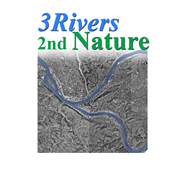Home> Further Inquiry> Art Publications
Art Publications
Collins, T. (2003) The Future: Could it be Ecohumanist Arts?.
(web page) excerpts from Art Nature and Aesthetics in the Post Industrial Public Realm in "Healing Natures, Repairing Relationships: New Voices on Restoring Ecological Spaces and Consciousness", Editor Robert France, MIT Press
We can no longer take nature for granted, its ability to maintain itself in the background, while humanity lives in the cultural foreground. We could describe the innocence of that recent period of background nature, as a second Eden. In the original garden, Adam and Eve only had to bite the apple, to acquire cultural awareness, and learn what they had lost. Today within what was what I would call a second Eden...
Collins, T., with Fielder, T., Prigann, H., Rosenthal, A., Wallen, R., and Van Western, J. (2003) Lyrical Expression, Critical Engagement, Transformative Action: An Introduction to Art and the Environment. (web page) Ed., Burnham L., Community Arts Network: Reading Room.
An overview of contemporary visual art practices that address the relationship between nature and the built environment, including some history and a touch of theory, as well as brief profiles of some interesting practitioners. Environment in a social context, with three modes of relevant practice: lyrical expression, critical engagement and transformative action.
Collins, T. (2000) Interventions in the Rust Belt: (3.5 mb pdf) Cultural Geographies In Practice, ECUMENE 7 (4)
Post-industrial public space should: Reveal the legacy of industrialism, not eradicate it or cloak it in nostalgia; create images and stories which reveal both the effect and the cause of the legacy...
Miles, M. (2000) Vistas of the Post - Industrial City. (1.2mb pdf) in "Advances in Art & Urban Futures Volume 1 - Locality, Regeneration & Divers(c)ites" eds. Bennett, S., Bulter, J. Bristol UK: Intellect Books
At the beginning of the twenty-first century, what are the possibilities for an art of urban engagement, which takes a position on issues such as democracy and power, or social justice, which is committed? It is not a question of mapping past avant-gardes onto today, not because there is nothing to be learned from history, nor even because past avant-gardes failed to deliver a new society, but because history is change. What is understood from past conditions may lead to insights into those present or future conditions most likely to bring about a particular direction of change; but present realities also require understanding if strategies are to be effective.
Collins, T. (2002) Conversations in the Rust Belt. (7.7mb pdf) in Herzogenrath, B., (ed.) "From Virgin Land to Disney World: Nature and Its Discontents in the America of Yesterday and Today." Amsterdam and Atlanta: Editions Rodopi.
Set in the context of Pittsburgh PA, the former steel capital of the United States, this paper explores the potential for a renewed civic or democratic dialogue on a specific brownfield development site. This case study, illustrates a three-part philosophy of discursive democracy, restoration ecology and reconstructive postmodernism and its experimental application by an interdisciplinary group of artists and academics working from a research facility in the college of fine arts at Carnegie Mellon University.
Thompson, I. (2001) The Pittsburgh Weddings. Landscape Design 298, pp. 13-15, pp 37-38 (4.6mb pdf)
In the first of two articles, Ian Thompson, describes two artist-landscape architect collaborations in Pittsburgh, Pennsylvania, United States of America, which are contributing to the city's cultural rebirth. If you have any image of Pittsburgh, Pennsylvania, it is probably of a smoke-blanketed city, ringed by steel mills and belching furnances. That picture is about 20 years out of date.
Collins, T., Goto, R. (2003) Landscape, Ecology, Art and Change. (4.7mb pdf) Eds. Miles, M., Hall, T. "Urban Futures" Routledge, London. p 134-143
Restoration ecology is the emerging paradigmatic relationship of humanity to nature. It has occurred in response to the industrial revolution and its massive programme utilising nature as both raw material and sink for wastes. Restoration ecology establishes a new relationship to nature by addressig a range of damaged land and water systems in both urban and rural settings. Restoration ecology is a community of disciplines, which acts upon natural systems through the sciences and engineering; and upon cultural values through the arts and humanities.
Collins, T. (2002) Three Rivers Second Nature - The River Dialogues. in "Advances in Art & Urban Futures Volume 2: Recoveries and Reclamations" eds. Rugg, J.,Hinchcliffe, D,. (3.2mb pdf) pp 67-75
As we emerge from an industrial culture, we must face the water problems, which follow the use of the rivers as a sink for wastes. We must consider the form and function of the post-industrial economy, and its attendant public space. The vegetation, which has prospered, as the economy languished and the riverside industrial sites crumbled provides and important component of a new urban/nature aesthetic. As we enter the post-industrial era in pursuit of renewed sewer infrastructure and the redevelopment of waterfronts, we must ask ourselves several critical questions: is it possible to consider the benefit of restored ecosystems as we rebuild infrastructure?
Miles, M. (2000) Reclamation: Nine Mile Run Greenway. "The Uses of Decoration: Essays in the Architectural Everyday" West Sussex UK: John Wiley & Sons: p 129 (10mb pdf)
The chapter contextualises the project within the growth of environmental art; and in relation to the issues raised by other reclamation projects, such as the Earth Centre (on a disused colliery site near Doncaster, in Yorkshire) within a discourse of post-industrial cities. The project's planning process is then investigated through the evidence of community workshops; and the problem, raised by the artists themselves, as to whether reclamation work of this kind remains art, is taken as a form of the wider problem of the relation of art's aesthetic and social dimensions.

